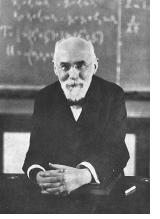Hendrik Antoon Lorentz
Physicist, b. 18 July 1853 (Arnhem, Netherlands), d. 4 February 1928 (Haarlem)
 Hendrik Lorentz received his doctoral degree in 1875 with a thesis on Maxwell's equations and became professor of mathematical physics at the University of Leiden, Holland, in 1878. Throughout his career he aimed at the development of a theory that would clarify the relationship between electromagnetism and light. It was generally accepted that electromagnetic radiation is produced by the oscillation of electrically charged particles, but what produces light was unknown.
Hendrik Lorentz received his doctoral degree in 1875 with a thesis on Maxwell's equations and became professor of mathematical physics at the University of Leiden, Holland, in 1878. Throughout his career he aimed at the development of a theory that would clarify the relationship between electromagnetism and light. It was generally accepted that electromagnetic radiation is produced by the oscillation of electrically charged particles, but what produces light was unknown.
Lorentz hypothesized that vibrations of electrically charged particles inside the atom could be responsible for the emission of light and argued that, if this were correct, a strong magnetic field should affect the oscillations and therefore the frequency of the emitted light. The effect was proven experimentally in 1896 by his student Zeeman, and in 1902 Lorentz and Pieter Zeeman received the Nobel Prize for their work.
In an attempt to explain the Michelson-Morley experiment of 1877 (which had failed to determine the velocity of the Earth through the hypothetical "ether" and shown that the measured velocity of light was the same in all directions) Lorentz in 1895 introduced the concept of different rates of time in different locations, which he called "local time." In 1904 he combined the concept with the proposal of George FitzGerald that bodies moving with a velocity approaching the speed of light contract in the direction of movement and developed a mathematical equation, now known as the Lorentz transformation, that describes quantitatively the relationship between increase of mass, shortening of length, and dilation of time. The Lorentz transformation forms the basis of Einstein's theory of special relativity.
In 1912 Lorentz became director of research at the Teylor Institute in Haarlem but continued to lecture at the University of Leiden.
home
 Hendrik Lorentz received his doctoral degree in 1875 with a thesis on Maxwell's equations and became professor of mathematical physics at the University of Leiden, Holland, in 1878. Throughout his career he aimed at the development of a theory that would clarify the relationship between electromagnetism and light. It was generally accepted that electromagnetic radiation is produced by the oscillation of electrically charged particles, but what produces light was unknown.
Hendrik Lorentz received his doctoral degree in 1875 with a thesis on Maxwell's equations and became professor of mathematical physics at the University of Leiden, Holland, in 1878. Throughout his career he aimed at the development of a theory that would clarify the relationship between electromagnetism and light. It was generally accepted that electromagnetic radiation is produced by the oscillation of electrically charged particles, but what produces light was unknown.